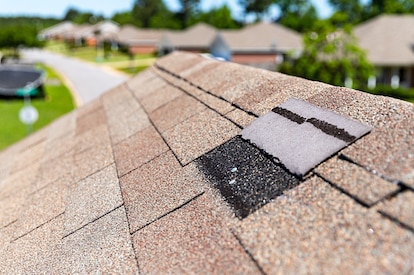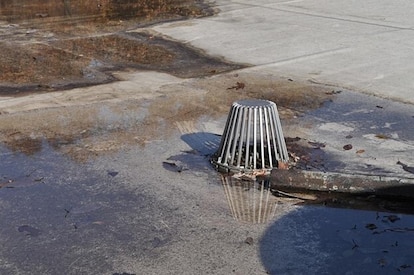
Your Home
Missing Shingles on Your Roof? Here's What to Do
If you notice missing shingles on your roof, there's no need to panic. Missing shingles aren't an emergency, but you should still act quickly, especially during wet seasons. Your roof is a multilayered system designed to protect your home's structure and finishes from water damage.If you ignore missing shingles, moisture can get into your home, leading to issues such as rot, mold, and costly water damage. Replacing missing shingles quickly can mean the difference between a minor roof repair and a total roof replacement.So, here's how to spot missing shingles and hire a roofer to replace them.How to Spot Missing ShinglesLocating missing shingles, before leaks set in, can save you time, money, and peace of mind. Here are several ways to spot them before they cause bigger issues.Inspect Your Roof from the GroundScope your roof with binoculars for signs of missing shingles. Inspecting your roof from the ground helps prevent shingle damage from walking on the roof and, most importantly, fall-related injuries. Scan your roof from every angle that it's safe to do so, including from streets, sidewalks, and neighbors' yards if you have permission to do so.Check for Shingle ChangesSystematically check each shingle following a horizontal or vertical line. A missing shingle often sticks out as a color change in your shingle pattern. While you're at it, look for shingles that are cracked, curled, or sagging or that aren't aligned with the others. These can all be signs of shingle or roof damage.Review Your Roof for Damage after StormsRoof damage often happens as a result of extreme weather. Once it's safe to be outdoors, visually inspect your roof for damage. You can also survey the ground around your property to spot any shingles that may have blown off.Look Inside Your Home for LeaksCheck inside your home for longer-term signs of missing shingles. Evidence of leaks in your attic or water stains on your interior ceilings or walls can indicate wider-spread water damage in your home. If you notice anything out of the ordinary, have a roofing professional inspect the area (both inside and outside) for damage.Schedule a Professional Roof InspectionThe National Roofing Contractors Association recommends professional-level roof inspections twice a year—once in the spring and once in the fall. Like routine car maintenance keeps repair costs down, roof inspections can help spot small concerns before they potentially become expensive problems.How to Hire a RooferOnce you spot missing shingles on your roof, the next step is hiring a professional to replace them. Create a list of questions before you call around, so you can find a reliable roofing company that won't cut corners.If you have warranties, you may also want to check whether or not those have any requirements. For example, all GAF roofing shingles and qualifying accessories (the "GAF Products") come with the coverage provided by the GAF Shingle & Accessory Limited Warranty,** and you don't need to do anything at all to get it.How to Prepare for Roofing RepairsThough every contractor is different, confirm certain details before signing any contracts. Here's how you can ensure you and your contractor are on the same page before work begins:Communicate clearly from the start; this will help prevent frustration and unexpected costs.Before making a deposit, be sure you both agree on the quote and job details.Agree on the job's start date, plus a contingency plan if bad weather forces a rain check. Ask your roofer if they'll install a temporary tarp to prevent water damage in the case of a delay.Read your quote carefully. Confirm approximate labor costs and the color, style, and brand of shingles that will be installed.Ask about anticipated material quantities and estimated roofing material costs (like flashing, roofing nails, etc.).Confirm whether the repair job includes cleanup costs and if the roofer will remove any debris.When to Consider a Roof ReplacementLook at the big picture before replacing missing shingles. Consider your roof's age, any warranties on your roof system, the extent of the roof damage (both internally and externally), and whether the missing shingles are an isolated issue. Multiple missing shingles or frequent repairs could be a sign that you need a new roof.Ready to schedule a professional roof inspection? Contact a GAF-certified roofing contractor* to get started.*Contractors enrolled in GAF certification programs are not employees or agents of GAF, and GAF does not control or otherwise supervise these independent businesses. Contractors may receive benefits, such as loyalty rewards points and discounts on marketing tools from GAF for participating in the program and offering GAF enhanced warranties, which require the use of a minimum amount of GAF products. Your dealings with a Contractor, and any services they provide to you, are subject to the GAF Contractor Terms of Use.* *GAF Accessory Products covered under this limited warranty include: GAF Ridge Cap Shingles, GAF Starter Strip Shingles, GAF Leak Barrier Products, GAF Roof Deck Protection Products, and GAF Attic Ventilation Products. For a complete list of qualifying GAF products visit gaf.com/LRS. This limited warranty does not cover low-slope membranes. See gaf.com for a copy of the limited warranties covering those products.
By Authors Annie Crawford
September 10, 2024



